Translate this page into:
Ethnobotanical diversity, phytochemical screening and biological evaluation of selected medicinal mushrooms species
⁎Corresponding authors. tabassumyaseen@bkuc.edu.pk (Tabassum Yaseen), javed89qau@gmail.com (Javed Iqbal), javed.iqbal@bkuc.edu.pk (Javed Iqbal), rashid.iqbal@iub.edu.pk (Rashid Iqbal)
-
Received: ,
Accepted: ,
This article was originally published by Elsevier and was migrated to Scientific Scholar after the change of Publisher.
Abstract
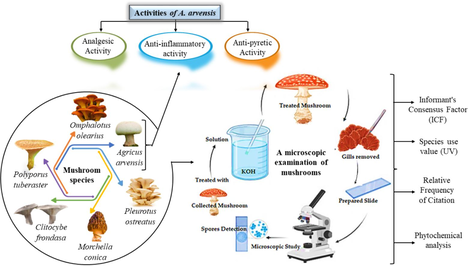
Abstract
The current study was aimed to investigate the ethno-pharmacology, diversity, biological potentials of different mushrooms species from District Swabi, Pakistan. Ethno-pharmacological data was collected from 73 respondents based on interview, group discussion and field visits. Quantitative analysis such as informant consent factor (ICF), Use value (UV), Relative Frequency of Citation (RFC) were done. Morphological identification of mushrooms, extract preparation, phytochemical screening and statistical analysis of data was conducted. Phytochemical analysis of six mushroom species revealed that saponins, alkaloids, glycosides, flavonoids and phenols were present in six selected mushrooms, while tannin and steroids (−) present in Agaricus arvensis. In Morchella conica only steroids (−) was absent, Qunion (−) in Polyporus tuberaster, Pleurotus ostreatus and Omphalotus olearius were found absent. Moisture contents (10.17 ± 1.27) and crude fats (5.26 ± 1.50) present in Omphalotus olearius. Highest content of crude fibers (26.57 ± 0.86) and carbohydrates (62.18 ± 0.73) were found in Pleurotus ostreatus. Highest ash contents (12.62 ± 0.46) were reported in Polyporus tuberaster. The respondents’ consensus factor values ranged from 1.66 to 61.74 in which highest ICF value was 61.74 while the lowest was 1.66. The high RFC was recorded for Agaricus (0.67) while lowest RFC was observed in Clitocybe frondasa (0.05). The results of analgesic activity were compared to the diclofenac (Standard drug). The extracts of aqueous and methanolic extract were most active at the level of (400 mg/kg). As antipyretic agents, methanolic and aqueous extracts of Agaricus species were analyzed for anti-inflammatory activity compare to diclofenac (Standard drug) where the aqueous (200 mg/kg) and methanolic (400 mg/kg) were found to be very active. Finally, mushrooms with high (ICF and UV) were further investigated for phytochemicals and pharmacological analysis which revealed significant biological potentials. This provides basic ground information which can be used to explore novel mushroom-based medicines for the treatment of various diseases. The commercial cultivation of mushrooms represents a promising opportunity to leverage their diverse health benefits and nutritional properties. By prioritizing research and cultivation methods while educating the public, the potential of mushrooms as vital components of both nutrition and medicine can be significantly realized, impacting health outcomes and contributing to sustainable agricultural practices.
Keywords
Analgesic
Anti-inflammatory
Antipyretic
Ethno-pharmacology
Mushrooms
Paralysis
1 Introduction
The term mushrooms (higher fungi) identify species describable to the kingdom of fungi that produce macroscopic fruiting bodies, mostly belonging to the phylum Basidiomycota and Ascomycota (Cardwell, 2018). About Fourteen thousand mushrooms species explored, round about two thousand are considered edible (Kirk et al., 2008). Approximately, thirty-three spp. edible mushrooms are cultivable in world, and only three spp. are easily cultivated, i.e. Agaricus bisporus Pleurotus ostreatus L. and Volvariella volvacea L. (Erbiai et al., 2021). A document on ethno-mycological knowledge possessed by the ethnic communities of Swat, Pakistan (2023) (Aly et al., 2011). Fungi play a key role; used in industries, Pharmacology Laboratories, companies and an important role in the production of secondary metabolites with biological activities that can be used for drug discovery (Ijaz et al., 2024a,b). Few mushrooms used in therapeutics folk medicine practices, such as traditional Chinese medicine such as Agaricus subrufescens and Ganoderma lucidum. Mushrooms produce different types of bioactive components, i.e phenolics, terpenoids, polysaccharides, glucans, and lectins, health benefitting effects, including anti-microbial, immune-modulating, antioxidant, antiviral, and hypo-cholesterol (Herawati et al., 2021). The presence of secondary metabolites in Auricularia, Schyzophyllum commune, and Trametes flavonoids, triterpenoids, saponins, and tannins, does not contain steroids, alkaloids, carotenoids, and M. xanthopus, contains flavonoids, saponins, tannins, coumarin, and steroids, but does not contain triterpenoids, alkaloids, or carotenoids (Srivastava et al., 2011). This study aims to explore the diversity, phytochemical, physiochemical and biological potentials of mushrooms from District Swabi. Due to the seasonal variation and extreme geographical conditions, Pakistan is hosting a rich diversity of mushrooms and is hub of many endemic species while the study areas are not yet explored in Swabi. Uses of mushrooms by native people traditionally may find a way to explore an alternate source of synthetic medicines. This will be initial one, most systematic and quantitative documentation of mushrooms from District Swabi, Pakistan.
2 Materials and methods
2.1 Survey description
Pakistan has an area of 80,943 km2 that lies between 60° 55′ to 75° 30′ E longitude and 23° 45′ to 36° 50′ N latitude. Pakistan has an altitude ranging from 0 to 8611 m. District Swabi located between river Indus and river Kabul, in the Khyber Pakhtunkhwa Province of Pakistan Fig. 1.
Different Mushrooms species were collected from District Swabi.
2.2 Collection, observations and identification of mushrooms
The study was conducted by interviewing 73 informants during August 2019–2020. Questionnaire was used for the collection of data regarding the mushrooms and their uses by local peoples of Swabi. Visits were arranged in different seasons i.e., winter, spring and summer for data gathering about mushrooms and traditional information. The different mushrooms species were collected from district Swabi for different activities, and for confirmation, photographs were also made at different angles at the time of collection. Samples were wrapped in papers, kept within zip-locks and brought to laboratory for further study very carefully. Mushrooms were morphologically identified and data was recorded for different parameters i.e., locality, habitat, season, type of soil and morphological features (Moore and O'Sullivan, 2013). Identification was also confirmed by comparing morphological features available in literature and for taxonomy, the Fungi of Pakistan (http://www.zobodat.at/stable/pdf/Sydowia_2_0072-0079.pdf (Kim, 2004).
2.3 Processing, drying and storage
Mushrooms were cleaned, dried for 2–3 weeks and processed and dried mushrooms were stored in a zip-lock polybag for further studies.
2.4 Microscopic examination
Solution of KOH 2.5 % was prepared and collected mushrooms treated with this solution for spore detection. Small pieces of the gills were cut from the fruiting body and mounted on a glass slide and microscopy was performed Fig. 2.
A microscopic examination of mushrooms.
2.5 Preparation of extracts
The extraction method was followed. Mushrooms were grinded and made powder. Extracts aqueous solutions (50:50, V/V) used as solvents isolation of pharmacologically active compounds from the mushroom. Physico-chemical analysis such as pH, temperature, salinity, conductivity and total dissolved solids (TDS) were determined out by water analyzer kit. Fig. 3.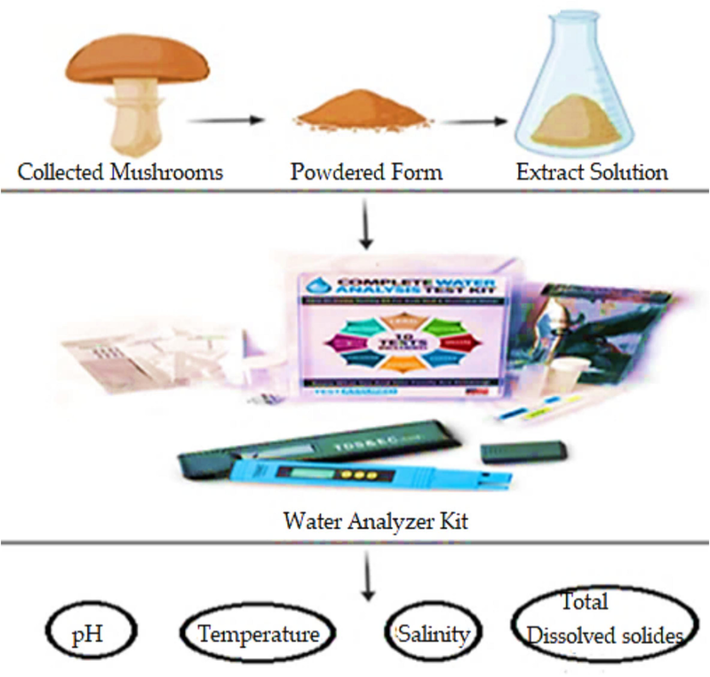
A procedure of extracts preparation from Mushrooms.
2.6 Phyto-chemical analysis
The methanol extract was tested for alkaloids, flavonoids, phenols, steroids, tannins, terpenoid, glycosides, saponins (Phillips and Gentry, 1993) Fig. 4.
Phytochemical screening from Mushrooms.
2.7 Quantitative analysis of ethno-pharmacology
Ethno-pharmacological information was collected from about 73 informants including farmers, herbalists, shepherds, pansaries and elders’ peoples. Data was analyzed by quantitative indices such as informant consent factor (ICF), Use value (UV), Relative Frequency of Citation (RFC) (Phillips and Gentry, 1993). Institutional Ethics and Research committee approved the experiments for data collection from human participants confirming that all experiments were performed in accordance with relevant guidelines and regulations.
2.8 Data analysis
Frequency of citation mentioned by the informants was counted for each species. Phillips and Gentry (Yasin et al., 2019). Formula below was used.
3 Results and discussion
3.1 Demographics data
Demographic sketch of informants is given Fig. 5 a total of 73 informants, the details of the gender, education, and age of the informants were recorded between 20 and 50 years. Among them, 18 were under the age of 40 or over 40 of which 10 were male and 8 females, while the remaining age was below 40. Education based observation documented that mostly 20–30-year older people are well educated as compared to other aged people. Informant were more male than female; its values were (41 males and 32 females) our results supported by (Hussain et al., 2023) documented the ethno pharmacological information of medicinal mushrooms from about 950 informants including males and females. Similarly, (Herawati et al., 2021) collected the ethno pharmacological information from about sixty-two informants. On the other hand, certain reports indicated that women have a more profound knowledge (Guissou et al., 2008).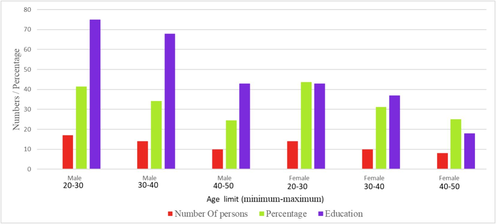
Demographic sketch of informants of District Swabi.
3.2 Diversity and medicinal value of documented species
Mushrooms species (including toxic species) were documented grouped into genera and families shown in Fig. 5 Species were used for the treatment of different diseases including; heart problems, brain diseases, arthritis, sex stimulant, purgative, laxative, body tonic, stomach problem, chronic diarrhea, constipation, asthma, allergies, microbial infections, cytotoxicity, wound healing, AIDS, cancer, tumor, frequent flu, colds, hyperlipidemia, hypertension, diabetes, hepatitis, osteoporosis, tuberculosis, ulcer, respiratory diseases, skin and liver diseases and are used as an antioxidant, antihypoxic, antihyperglycemic by the local inhabitants. Similarly, (Ullah et al., 2022) reported the consumption of mushrooms by the native for the treatment of different diseases. Our study showed pivotal role of female in the field of ethno-mycology. Few researchers investigated the importance of medicinal uses of mushrooms like antioxidant, anticancer, antidiabetic, antiallergic, cardiovascular protector, anticholesterolemic, antibacterial, antiparasitic, antifungal, detoxification, and hepatoprotective etc (Chang and Wasser, 2012).
3.3 Description of mushrooms
The description of each mushroom included scientific name and medicinal uses are given in Table S1. Similar classification was proposed by (Reyes-López et al., 2020). Total Fifty mushrooms species were collected Table S1. They were grouped in to different number of families. Agaricaceae followed by Polyporaceae and Omphalotaceae. The results given in Table S1 revealed that Morchella conica, Agaricus arvensis, used for the treatment of heart and brain problems. Similarly, (Ramya et al., 2022) reported that mushrooms also helpful relief in arthritis. Morchella esculenta, Agaricus campestris, Lactarius deliciosus, Cerioporus squamosus, Macrolepiota rachodes, Protostropharia semiglobata, Ganoderma applanatum, Fomes fomentarius and Helvella crispa were used for purgative, laxative and as a body tonic. Other studies have also reported similar local people used Auricularia sp. As laxative, astringent for the treatment of common cold and hypertensive (Herawati et al., 2021). Our results are also in line with that of (Hussain et al., 2023) they determined that Coprinus sterquilinus (Fr.) Fr. species of mushrooms help to promote digestion, antidote and as an anticancer agent. Terpenes in turn are responsible for the antioxidant, anticancer and anti-inflammatory activities including other biological activities exercised by mushrooms (Yaseen et al., 2016). Some mushrooms like Daldinia concentric used for Hernia, Ganoderma lucidum, Auricularia auricular, Trametes versicolor and Fomitopsis pinicola used for respiratory diseases few used for stomach ulcer, control the level of glucose in blood, skin disease etc. Our finding is a line with (Booi et al., 2023) mushrooms for respiratory disorders and Sparassis crispa, Fomitopsis pinicola and Agaricus bisporus are used for skin and liver diseases.
3.4 Quantitative study
3.4.1 Informant's consensus factor (ICF)
The documented ethno medicinal mushrooms were used to treat 36 different ailments presented in Table S2. The informant's consensus factor values ranged from 1.66 to 61.74. The highest ICF value was 61.74 was for cancer disorders followed by microbial infection (34.72), while the lowest ICF value was 1.66 for skin diseases. Similar result was also proposed by (Khastini et al., 2018). Informant consensus factor by category of different ailment within the current study of mushrooms is given in supporting information file Table S2.
3.4.2 Species use value (UV)
In the current study, the species use value ranged between 0.15 and 0.79. Based on (UV) data, the seven most commonly used ethno medicinal mushrooms including species highest in Pleurotus ostreatus (0.87) followed by Agaricus arvensis (0.79) and lowest in mphalotus olearius (0.15) shown in Table S3. These species were used for diverse purposes for the treatment of skin and liver diseases, respiratory, hepatitis, osteoporosis, tuberculosis, ulcer, blood circulation, weight loss, vitamins, AIDS, cancer, tumor, frequent flu, colds, hyperlipidemia, hypertension, diabetes, antimicrobial, cytotoxicity, antioxidant, antihypoxic, antihyperglycemic, wound healing, iron-chelation activity, chronic diarrhea, constipation, asthma, allergies, promote digestion, stomach problem, boost the immune system, purgative, laxative, body tonic, arthritis, sex stimulant, disease of heart and brain. Similarly, (Yasin et al., 2018) found highest UV was recorded for Xylobolus subpileatus (0.42), Morchella esculenta (0.284) and Chlorophyllum brunneum (0.245. The species use value within the current study of mushrooms is given in supporting information file Table S3.
3.4.3 Relative frequency of citation
RFC values from range from 0.(05–0.65).The highest RFC recorded for Agaricus arvensis (0.65) and Omphalotus olearius (0.64) showed in Table S4. Lowest was observed in Morchella conica (0.05). These results were supported by [26]. RFC within this study of mushrooms is given in supporting information file Table S4.
3.5 Phytochemical analysis of selected mushrooms
Phyto-chemical qualitative screening of the aqueous extracts of mushrooms, i.e., Pleurotus ostreatus, Agaricus arvensis, Polyporus tuberaster, Morchella conica, clitocybe frondasa, and Omphalotus olearius contained tannins, saponins, quinones, alkaloids, steroids, glycosides, flavonoids, triterpenoids and phenolic compounds. Results given in Table.1 showed that quinones and triterpenoids were absent in the aqueous extracts of Pleurotus ostreatus species. The aqueous extract of Agaricus arvensis only steroids and tannin showed their occurrence.
Mushrooms
Tannin
Saponin
Quinone
Alkaloid
Steroid
Glycoside
Flavonoids
Terpenoid
Phenol
Pleurotus ostreatus
+
+
−
+
+
+
+
−
+
Agaricus arvensis
−
+
+
+
−
+
+
+
+
Polyporus tuberaster
+
+
−
+
+
+
+
+
+
Morchella conica
+
+
+
+
−
+
+
+
+
Clitocybe frondasa
+
+
−
+
+
+
+
+
+
Omphalotus olearius
+
+
−
+
+
+
+
+
+
The fresh white oyster extractions had alkaloids, steroids, flavonoids, saponins, tannins and phenolic components while, quinones and triterpenoids were absent (Rahimah et al., 2019). Qualitative study showed the extracts of Agaricus arvensis and Pleurotus ostreatus contain possessed alkaloids, anthraquinone, tannins, saponins, flavonoids, sterols and phlobatannins (Alshammaa, 2017). The ethanolic extract of P.ostreatus is an exogenous antioxidant that can inhibit oxidative stress due in the body. The aqueous extract of Polyporus tuberaster species contains tannin, saponin, alkaloids, steroids, glycosides, triterpenoid, flavonoids, and phenol except quinone, which was absent, while Morchella conica extract found tannin, saponin, quinone, alkaloids, glycosides, flavonoids, triterpenoid, and phenol, whereas steroids were not documented. Similarly, M. esculenta phytochemical analysis showed the presence of alkaloids, anthraquinone, anthocyanins, tannins, saponins, glycosides, flavonoids, terpenoids, phenols, carbohydrates as well as proteins and amino acids, only steroids are absent (Bishop et al., 2015). The aqueous extracts of Omphalotus olearius showed the presence of tannin, saponin, alkaloids, steroids, glycosides, triterpenoid, flavonoids, and phenol, except quinine, which was absent in both mushrooms. There are novel anticancer terpenoids reported from certain mushrooms like Inonotus obliquus (Sasidhara and Thirunalasundari, 2014). Bioactive secondary metabolites of mushrooms extracted may be different depending on the extractive solvent (Hassan and Medany, 2014).
3.6 Physiochemical analysis of selected mushrooms
The documented results showed that highest moisture content was present in Omphalotus olearius (10.17 ± 1.27) followed by Clitocybe frondasa (9.50 ± 2.44) > Pleurotus ostreatus (4.76 ± 1.06) > Polyporus tuberaster (4.52 ± 0.95) > Morchella conica (3.97 ± 0.70) > Agaricus arvensis value (2.77 ± 1.37) Table. 2. Our results agree with (Sadli et al., 2021) reported 7.93 % of moisture content of P. ostreatus pretreated in NaCl prior to drying. Similarly, (Sadli et al., 2021) reported that Oyster mushrooms have a high moisture content (92.65 %). Highest protein content (36.90 ± 1.40) was reported in Clitocybe frondasa and lowest (17.43 ± 0.61) in Omphalotus olearius. Our findings are similar with that of (Odoh et al., 2017) investigated fat contents of edible mushrooms studied ranged from 1.11 − 8.43 %. C. cornucopioides and T. matsutake had the highest fat contents of 8.43 and 7.32 %, respectively while Morchella sp. and C. gigantea had the lowest fat contents of 1.31 %. Highest crude fibers (26.57 ± 0.86) were found in Pleurotus ostreatus and lowest (3.16 ± 0.30) levels were found in Omphalotus olearius. Highest (12.62 ± 0.46) ash contents were found in Polyporus tuberaster and lowest (7.83 ± 0.30) recorded for Omphalotus olearius. Our results are supported by the findings of (Muthu and Shanmugasundaram, 2016), they found Ash content to be low (1.22 mg/100 g) when compared to the fiber and moisture content in mushroom. Highest carbohydrates contents (62.18 ± 0.73) were found in Pleurotus ostreatus and lowest (38.56 ± 1.39) in Morchella conica. According to (Ashraf et al., 2013) mushrooms is a potential source of total carbohydrates (38-.62 % −66.78 %) depending upon the species. Furthermore, (Kayode et al., 2013) stated that the carbohydrate content of mushrooms represents the volume of fruiting bodies accounting for about 50 to 65 % on dry weight basis.
Species Name
Moisture contents
Crude protein
Crude fats
Crude fibers
Total ash
Carbohydrates
Agaricus arvensis
2.77 ± 1.37
29.90 ± 3.35
3.45 ± 0.97
24.60 ± 1.2
9.39 ± 0.44
55.33 ± 11.4
Clitocybe frondosa
9.50 ± 2.44
36.90 ± 1.40
4.73 ± 0.38
9.13 ± 0.47
12.60 ± 0.26
40.26 ± 5.95
Morchella conica
3.97 ± 0.70
29.30 ± 1.90
3.63 ± 1.25
17.20 ± 1.1
8.33 ± 0.55
38.56 ± 1.39
Omphalotus olearius
10.17 ± 1.2
17.43 ± 0.61
5.26 ± 1.50
3.16 ± 0.30
7.83 ± 0.30
48.16 ± 1.30
Pleurotus ostreatus
4.76 ± 1.06
22.31 ± 1.81
3.61 ± 0.59
26.57 ± 0.8
8.28 ± 0.38
62.18 ± 0.73
Polyporus tuberaster
4.52 ± 0.95
34.00 ± 0.83
3.75 ± 1.08
15.15 ± 2.8
12.62 ± 0.46
42.23 ± 2.38
3.7 Biological activity of A. arvensis
3.7.1 Analgesic activity
In this test, aqueous and methanolic extract of A. arvensis were used in two different doses (200 mg/Kg, and 400 mg/Kg) for analgesic activity. The results of analgesic activity were comparable to diclofenac (Standard drug). The extracts of aqueous and methanolic were most active at the dose level of 400 mg/kg body weight after the twenty and forty minutes of treatment in Fig. 6. Similarly, (Bose et al., 2019) used A. bisporus extract at (250 and 500 mg/kg) in methanolic and aqueous. One of the main constituents of the mushroom is Riboflavin, also called as Vitamin B2, which can act as an anti-inflammatory and analgesic agent (Singh et al., 2014). Alkaloids are also present in greater quantity than other constituents in the extract which may give analgesic and anticancer effect (Patel and Goyal, 2012).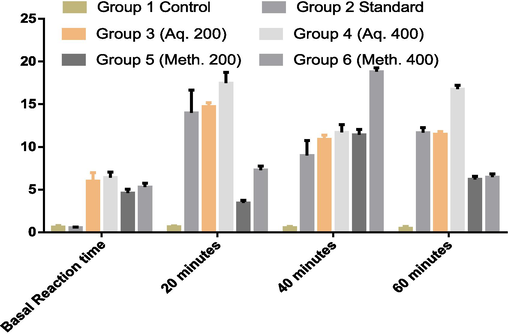
Analgesic effects of aqueous and methanolic (200 and 400) extracts of mushrooms Agaricus arvensis in rats by the method of Eddy’s hot plate.
3.7.2 Anti-pyretic activity
The A. arvensis aqueous and methanolic extracts showed very anti-pyretic activity in mice. The activities of anti-pyretic and extracts of A. arvensis were comparable to (Standard drug) diclofenac. The aqueous extracts were most active at the dose level of 200 mg/kg and in methanolic extract on 400 mg/kg, body weight after the twenty minutes of treatment as antipyretic agents Fig. 7. Our result also coincides with the earlier works which proves that the methanolic extract of different mushrooms have strong antipyretics capacity (Khatua et al., 2013). Our results are also in agreement with (Sabo et al., 2010). Antipyretics such as paracetamol used in management of fever function through several ways by reducing levels of prostaglandins acting on cyclooxygenase enzymes, enhancing antipyretic message within brain and stimulating anti-inflammatory signals at injury site (Aronoff and Neilson, 2001).
Anti-pyretic effects of aqueous and methanolic (200 and 400) aqueous extracts of mice.
3.7.3 Anti-inflammatory activity
In the extract of methanolic and aqueous of A. arvensis used for anti-inflammatory activity compare to diclofenac (Standard drug). After the twenty minutes of treatment, the aqueous extract (200 mg/kg) and methanolic extract (400 mg/kg) were found to be very active at body weight Fig. 8. Several studies have been conducted to evidence the bioactive properties of mushroom extracts as well as of their secondary metabolites such as antioxidant, anti-inflammatory, antimicrobial and immunomodulatory activities (Choi et al., 2014).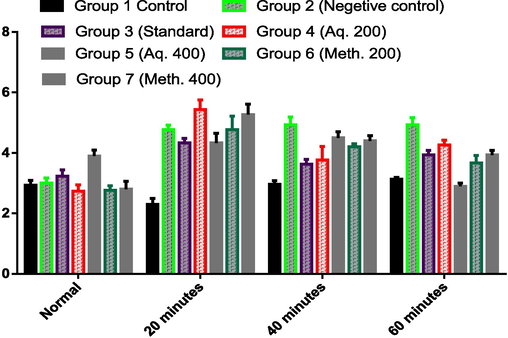
Anti-inflammatory effects of aqueous methanolic (200 and 400) extracts of Agaricus aevensis on carrageenan-induced inflammation in mice.
4 Conclusion
The current study has provided complete insights into the multifaceted aspects of including Ethnopharmacological exploration, physiochemical, phytochemical analyses and biological activities of different mushrooms species from district Swabi, KPK, Pakistan. This total approach allows for a deeper understanding of biology, medicine and chemistry (chemicals), as well as their applications in the health and pharmaceutical industries. Numerous species have been found through comprehensive field surveys and taxonomical analysis, highlighting the significance of the region as a hotspot for mushroom diversity. Furthermore, the Ethnopharmacological study clarified the customary beliefs and methods of nearby societies concerning the medicinal applications of fungi. Important information on the therapeutic qualities of several mushroom species, such as their involvement in treating immune system modulation, respiratory diseases, and digestive disorders, was acquired through interviews and ethnobotanical surveys. This traditional wisdom establishes a foundation for future scientific investigation into the medicinal potential of mushrooms in addition to highlighting their cultural relevance. To assess the nutritional value and chemical makeup of particular mushroom species, physiochemical and phytochemical examinations were carried out in addition to ethnobotanical research. Important nutrients, bioactive substances, and secondary metabolites with possible health benefits were found in these investigations. These results not only support the conventional applications of mushrooms but also open the door for their usage in nutraceuticals and functional meals. Further, different biological activities were performed which revealed strong analgesic, antipyretic and anti-inflammatory potentials. These investigations are critical to ensuring the efficacy, safety, and quality of products obtained from mushrooms in the pharmaceutical and healthcare industries. This comprehensive exploration and ethnomedicinal, phytochemical, and pharmacogenetic studies of mushrooms in District Swabi have enriched our understanding of their ecological, medicinal, and chemical attributes. The synergistic integration of traditional knowledge with scientific methodologies has unveiled the immense potential of mushrooms as valuable resources for healthcare, nutrition, and pharmaceutical development. Moving forward, further interdisciplinary research and conservation efforts are warranted to harness the full spectrum of benefits offered by mushrooms while ensuring their sustainable utilization and conservation.
5 Ethics approval.
Not Applicable
6 Consent to participate
All authors consent to participate in this manuscript.
7 Consent for publication
All authors consent to publish this manuscript in Journal of King Saud University – Science.
8 Code availability
Not Applicable.
Author contributions
S. A.H., T.Y, B.A.A., and J.I., designed and conceived the study idea. .S.A.H., completed the experiments. S.I., S.N., M. M., S.S.A.R., S.A., and R.I., analysed the data and performed visualizations and statistical data analysis. S.A.H., and J.I., wrote the original draft. S.I., S.N., reviewed and edited the manuscript. M. M., S.S.A.R., reviewed the manuscript and provided funds. T.Y., provided the resources and supervision. All authors made valuable revisions and edited the manuscript and approved the last version.
Funding
The authors extend their appreciation to the Researchers Supporting Project number (RSP2024R120) King Saud University, Riyadh, Saudi Arabia.
CRediT authorship contribution statement
Syed Adil Hayat: Conceptualization, Methodology, Writing – original draft, Writing – review & editing. Tabassum Yaseen: Conceptualization, Resources, Supervision, Writing – original draft, Writing – review & editing. Banzeer Ahsan Abbasi: Conceptualization, Software, Writing – original draft, Writing – review & editing. Javed Iqbal: Conceptualization, Writing – original draft, Writing – review & editing. Shumaila Ijaz: Formal analysis, Software, Writing – review & editing. Salma Noreen: Formal analysis, Software, Writing – review & editing. Mohamed Mohany: Formal analysis, Writing – review & editing, Funding acquisition. Salim S. Al-Rejaie: Formal analysis, Funding acquisition, Writing – review & editing. Saltanat Aghayeva: Formal analysis, Software, Writing – review & editing. Rashid Iqbal: Formal analysis, Conceptualization.
Acknowledgment
The authors extend their appreciation to the Researchers Supporting Project number (RSP2024R120) King Saud University, Riyadh, Saudi Arabia.
Declaration of Competing Interest
The authors declare that they have no known competing financial interests or personal relationships that could have appeared to influence the work reported in this paper.
References
- Phytochemical investigation and quantitative comparison of ergosterol between Agaricus bisporus and Pleurotus ostreatus by HPLC and GC-MS Methods. Int. J. Pharm. Sci. Rev. Res.. 2017;44(2):215-220.
- [Google Scholar]
- Antipyretics: mechanisms of action and clinical use in fever suppression. Am. J. Med.. 2001;111(4):304-315.
- [Google Scholar]
- Effect of different substrate supplements on oyster mushroom (Pleurotus spp.) production. Food Sci. Technol. (. 2013;1(3):44-51.
- [Google Scholar]
- From 2000 years of Ganoderma lucidum to recent developments in nutraceuticals. Phytochemistry. 2015;114:56-65.
- [Google Scholar]
- Medicinal Mushrooms for Respiratory Health. In: Mushrooms with Therapeutic Potentials: Recent Advances in Research and Development. Springer Nature Singapore: Singapore; 2023. p. :55-96.
- [Google Scholar]
- Phytochemical and pharmacological potentials of Agaricus bisporus. Res. J. Pharmacy Technol.. 2019;12(8):3811-3817.
- [Google Scholar]
- A review of mushrooms as a potential source of dietary vitamin D. Nutrients. 2018;10(10):1498.
- [Google Scholar]
- The role of culinary-medicinal mushrooms on human welfare with a pyramid model for human health. Int. J. Med. Mushrooms. 2012;14(2)
- [Google Scholar]
- Anti-inflammatory and heme oxygenase-1 inducing activities of lanostane triterpenes isolated from mushroom Ganoderma lucidum in RAW264. 7 cells. Toxicol. Appl. Pharmacol.. 2014;280(3):434-442.
- [Google Scholar]
- Chemical composition, bioactive compounds, and antioxidant activity of two wild edible mushrooms Armillaria mellea and Macrolepiota procera from two countries (Morocco and Portugal) Biomolecules. 2021;11(4):575.
- [Google Scholar]
- Declining wild mushroom recognition and usage in Burkina Faso. Econ. Bot.. 2008;62:530-539.
- [Google Scholar]
- Effect of pretreatments and drying temperatures on the quality of dried Pleurotus mushroom SPP. Egypt. J. Agric. Res.. 2014;92:1009-1023.
- [Google Scholar]
- Phytochemical screening and antioxidant activity of wild mushrooms growing in tropical regions. Biodiversities J. Biol. Diversity. 2021;22(11)
- [Google Scholar]
- Traditional Uses of Wild Edible Mushrooms among the Local Communities of Swat, Pakistan. Foods. 2023;12(8):1705.
- [Google Scholar]
- Investigation of bioactive constituents and evaluation of different in vitro antimicrobial, antioxidant, and cytotoxicity potentials of different Portulacaria afra extracts. J. King Saud University-Sci.. 2024;36(2):103033
- [Google Scholar]
- Investigation of bioactive constituents and evaluation of in vitro bioactivities of different Setaria glauca extracts. J. King Saud University-Sci. 2024103321
- [Google Scholar]
- Nutritional composition and antibacterial activity of indigenous edible mushroom Agaricus heterocystis. Int. J. Adv. Biotechnol. Res.. 2013;4(1):78-84.
- [Google Scholar]
- Ethnomycology of Bracket Fungi in Baduy Tribe Indonesia, Biosaintifika. J. Biol. Biol. Educ.. 2018;10(2):423.
- [Google Scholar]
- Mushroom as the potential source of new generation of antioxidant: a review. Res. J. Pharmacy Technol.. 2013;6(5):496-505.
- [Google Scholar]
- Kim, B.S., 2004. Mushroom storage and processing. Mushroom Growers’ Handbook 1, pp. 193–196.
- Dictionary of the Fungi (10th ed.). Wallingford, UK: CAB International; 2008.
- A guide to common fungi of the Hunter-Central Rivers region. Hunter-Central Rivers Catchment Management Authority; 2013.
- Proximate and mineral compositions of edible mushroom Agro cybeaegerita. J. Pharmacognosy Phytochemistry. 2016;5(1):116-119.
- [Google Scholar]
- Proximate composition and mineral profiles of selected edible mushroom consumed in northern part of Nigeria. Acad. J. Sci. Res.. 2017;5(9):349-364.
- [Google Scholar]
- Recent developments in mushrooms as anticancer therapeutics: a review. Biotech. 2012;2(1):1-15.
- [Google Scholar]
- The useful plants of Tambopata Peru: I. Statistical hypotheses tests with a new quantitative technique. Economic Bot.. 1993;47:15-32.
- [Google Scholar]
- The phytochemical screening, total phenolic contents and antioxidant activities in vitro of white oyster mushroom (Pleurotus ostreatus) preparations. Open Access Macedonian J. Med. Sci.. 2019;7(15):2404.
- [Google Scholar]
- Morel mushroom, Morchella from Kashmir Himalaya: a potential source of therapeutically useful bioactives that possess free radical scavenging, anti-inflammatory, and arthritic edema-inhibiting activities. Drug Chem. Toxicol.. 2022;45(5):2014-2023.
- [Google Scholar]
- Folk classification of wild mushrooms from San Isidro Buensuceso, Tlaxcala, Central Mexico. J. Ethnobiol. Ethnomed.. 2020;16(1):1-21.
- [Google Scholar]
- Pharmacodynamic action of a commercial preparation of the mushroom Coprinus comatus in rats. Phytother. Res.. 2010;24(10):1532-1537.
- [Google Scholar]
- Sadli, S., Saleha, S., Fiana, D., Misrahanum, M., 2021, November. The formulation of white oyster mushroom (Pleurotus ostreatus (Jacq.) P. Kumm) as natural flavoring and the quality test in temperature and drying time variations. In IOP Conference Series: Earth and Environmental Science, Vol. 922, No. 1, IOP Publishing, p. 012054.
- Phytochemicals and antioxidant potentials of Pleurotus djamor. J. Chem. Pharm. Res.. 2014;6(4):950-953.
- [Google Scholar]
- Morphological characterization and yield potential of Termitomyces spp. mushroom in Gorakhpur forest division. Bulletin of environment, pharmacology & life. Sciences. 2011;1(1):54-56.
- [Google Scholar]
- Diversity and ethnomycological importance of mushrooms from Western Himalayas, Kashmir. J. Ethnobiol. Ethnomed.. 2022;18(1):1-20.
- [Google Scholar]
- Morphological study of edible and non- edible mushrooms, district Swabi, Khyber Pakhtunkhwa, Pakistan. Pure Appl. Biol.. 2016;5(4):889-894.
- [Google Scholar]
- Ethnopharmacological exploration of medicinal Mushroom from Pakistan. Phytomedicine 2018
- [CrossRef] [Google Scholar]
- Ethnopharmacological exploration of medicinal mushroom from Pakistan. Phyto Medicine. 2019;54:43-55.
- [Google Scholar]
Appendix A
Supplementary data
Supplementary data to this article can be found online at https://doi.org/10.1016/j.jksus.2024.103428.
Appendix A
Supplementary data
The following are the Supplementary data to this article:







